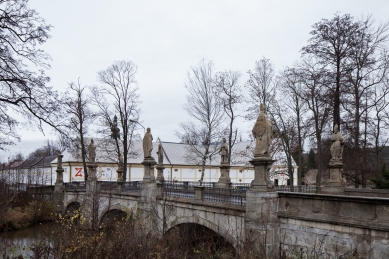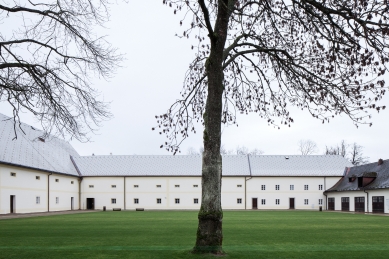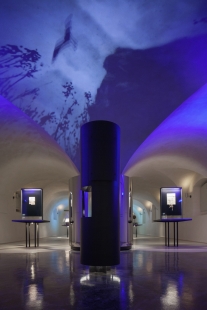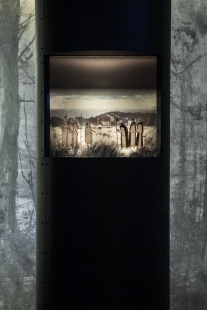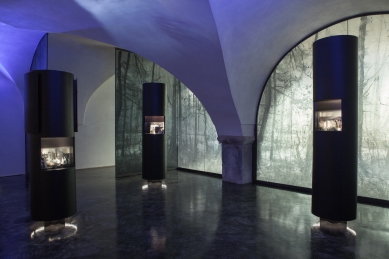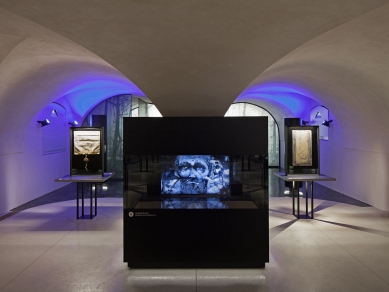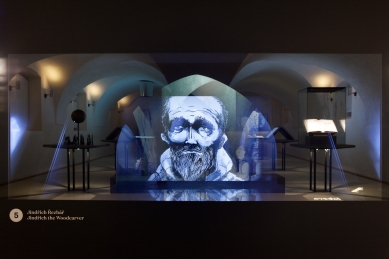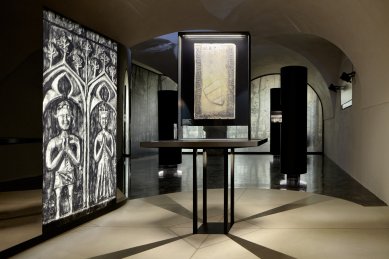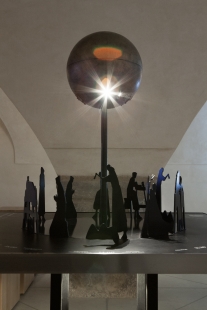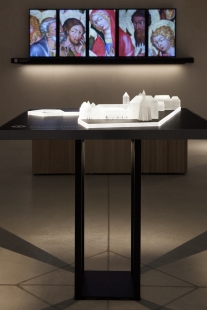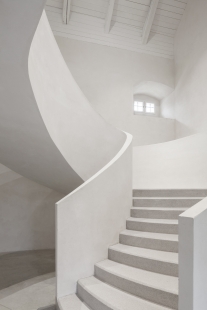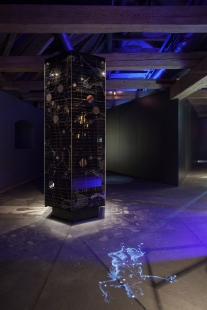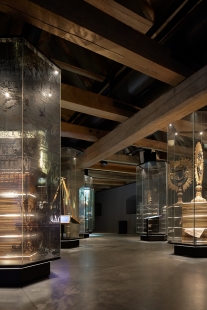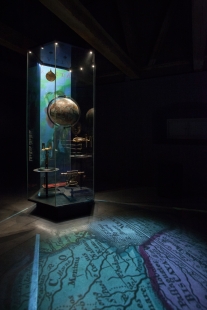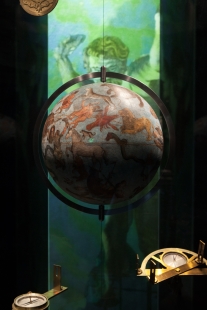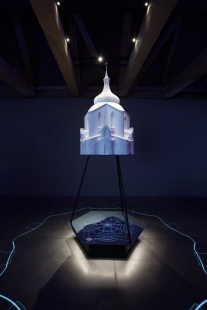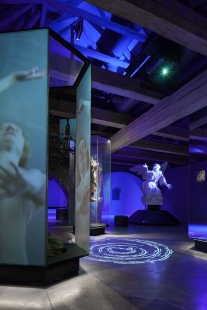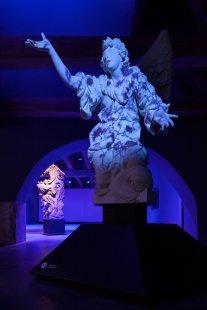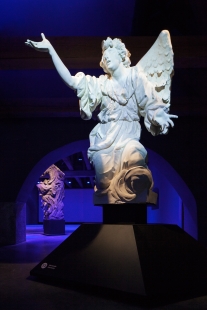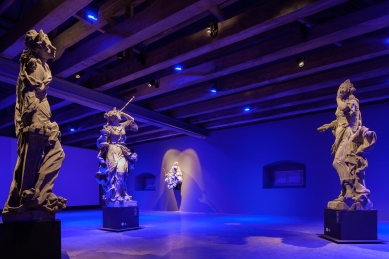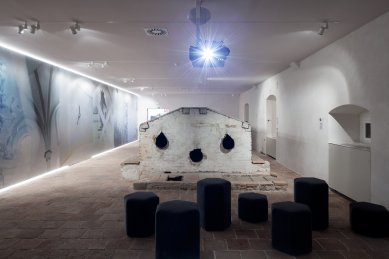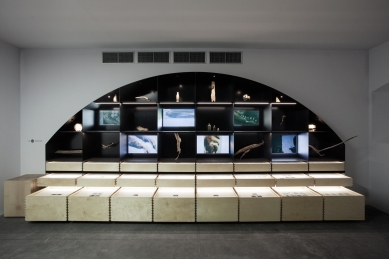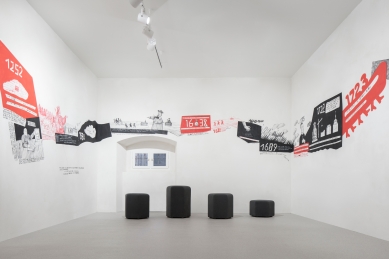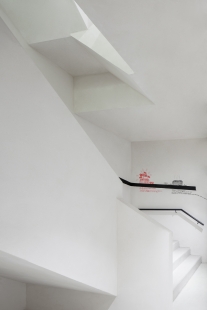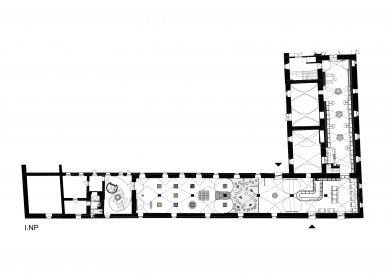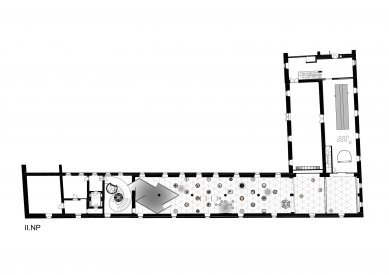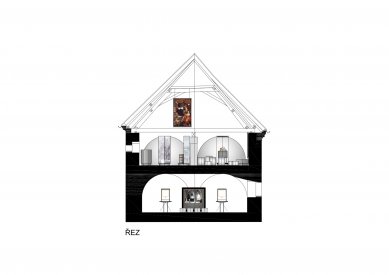
Museum of the New Generation
Exhibition at the Žďár nad Sázavou Castle

MUSEUM
The museum is built into the original building of the old brewery of the Žďár monastery. Two main entrances (one through the original farmyard and a new one built on the outer side of the complex) lead visitors into the entrance foyer of the two-story building. The foyer includes a ticket office and a bistro. From here, the visitor begins their journey through the history of the monastery, interpreted through a new multimedia exhibition.
BASIC CONCEPTUAL PRINCIPLES OF SCENOGRAPHIC DESIGN
The overall concept of this exhibition is based on an interpretative and experiential form of presentation.
The visitor is not confronted solely with an exhibit and descriptive text, but is told a complex story, overall animated by a grand commentary accompanied by artistic and theatrical installations, animated images projected within the exhibition space, and installed artistic models of architectural and other elements.
The interface between the visitor and the exhibition itself is aimed at their emotional side. It engages their enthusiasm and curiosity, which lead them into a deeper understanding of the presented topic. The staged history of Žďár unfolds before our eyes…
Theatricality: the richness of the installation realized on the border of artistic and theatrical domains with immersive passages aims to provoke, touch, or stimulate questions within the visitor – a desire for knowledge.
Levels of interpretation and experience: these are individual; the exhibition offers each person a different dose of understanding, different means for absorbing these perceptions and information.
Life and attractiveness: the interpretative center is a lively place. The position of the visitor and their relationship to the content changes continuously due to the wide variety of means used, leading to a constant revival of their interest and stimulating their feelings and intellect.
Mediation and conversation: Each interpretative medium is carefully selected in accordance with the message it is meant to convey. The individual components presented here are conceived as parts of a conversation: each tells the visitor something.
TECHNICAL CONCEPT - AUDIO GUIDE
The reception area will need to be adapted to the requirements for issuing and collecting devices. Their storage and recharging may take place in other areas. It is necessary to ensure the return of the device upon departure. Instructions for the device will be available at the issuing station. The operation will be straightforward, technically uncomplicated – in the vast majority of cases, the visitor will activate the device by selecting the relevant code (marked in the display case)
SPACE ORGANIZATION
The entire subsequent space is rhythmically organized with a regular structure of exhibition tables, each bearing a different exhibition attribute. The regular arrangement of the tables corresponds to the module of the building and the regular structure of arches and columns in this exhibition space. In the middle of the regular structure lies an optical theatre where the visitor will first meet the monks who will tell them their story.
Connecting staircase:
Upon leaving the Cistercian Gallery, the visitor finds themselves in the space of the connecting staircase – a distinctive architectural novelty of the staircase structure leads visitors to the first floor. Their steps are accompanied by period music and light.
Baroque Gallery:
From the staircase space, the entrance to the Baroque Gallery opens through a gate formed by a large mirrored kaleidoscope – an immersive installation reflecting the theme of infinity and especially the boundless richness of Baroque art and creative force. The visitor moves through this space and finds themselves in a regular structure of hexagonal fully glass display cases. In the first section, they are introduced to Baroque values of a general nature; in the second part, they become acquainted with the Žďár region. In the middle, there is similarly a theatre – a meeting with Abbot Vejmluva (projection on the wall).
Žďár today:
The third and final gallery of the exhibition is Žďár Today. The central feature of this gallery is a final presentation consisting of synchronized projection and mapping of historical developmental stages onto a model of the monastery. After the presentation, the visitor finds themselves in a hall, through which they return to reality. An explosion of photographs of details and elements of important places in the Žďár estate and its surroundings invites the visitor to explore the entire complex. Important period elements of economic significance are also presented – Baroque fishponds, malt dryers, hop washers. A coherent view of the Green Mountain.
Exit staircase:
The visitor descends to the ground floor via the staircase. Along the way, they can study a timeline drawn directly on the walls of this space – this will offer them a recap of historical events both in the locality and in the world.
Visitor book, shop, café:
At the end of the timeline, there is an unusually conceived visitor book, where visitors can leave a message indicating the specific place to which the message pertains. The visitor book is located directly within the museum shop space. At the end of the tour, the visitor finds themselves back in the reception area, where they return the audio guide. They can refresh themselves in the café, study accompanying programs in the museum and surrounding area on the integrated screens, and subsequently set out on an individual walk.
The museum is built into the original building of the old brewery of the Žďár monastery. Two main entrances (one through the original farmyard and a new one built on the outer side of the complex) lead visitors into the entrance foyer of the two-story building. The foyer includes a ticket office and a bistro. From here, the visitor begins their journey through the history of the monastery, interpreted through a new multimedia exhibition.
BASIC CONCEPTUAL PRINCIPLES OF SCENOGRAPHIC DESIGN
The overall concept of this exhibition is based on an interpretative and experiential form of presentation.
The visitor is not confronted solely with an exhibit and descriptive text, but is told a complex story, overall animated by a grand commentary accompanied by artistic and theatrical installations, animated images projected within the exhibition space, and installed artistic models of architectural and other elements.
The interface between the visitor and the exhibition itself is aimed at their emotional side. It engages their enthusiasm and curiosity, which lead them into a deeper understanding of the presented topic. The staged history of Žďár unfolds before our eyes…
Theatricality: the richness of the installation realized on the border of artistic and theatrical domains with immersive passages aims to provoke, touch, or stimulate questions within the visitor – a desire for knowledge.
Levels of interpretation and experience: these are individual; the exhibition offers each person a different dose of understanding, different means for absorbing these perceptions and information.
Life and attractiveness: the interpretative center is a lively place. The position of the visitor and their relationship to the content changes continuously due to the wide variety of means used, leading to a constant revival of their interest and stimulating their feelings and intellect.
Mediation and conversation: Each interpretative medium is carefully selected in accordance with the message it is meant to convey. The individual components presented here are conceived as parts of a conversation: each tells the visitor something.
TECHNICAL CONCEPT - AUDIO GUIDE
Audio guide:
The audio guide technology constitutes the backbone structure of this exhibition's concept. Every visitor receives an audio guide when purchasing a ticket. It is an integral part of the equipment. With this electronic device, each visitor receives a true guide – a voice – a characterful and trustworthy narrator who will accompany them throughout the exhibition. The voice of the characterful actor/narrator engages in dialogue with historical and fictional characters, explains historical facts, shares anecdotes from life, and offers deeper insights in case of interest (the possibility to evoke extended commentary) – moderating the entire tour, passing the floor, and inquiring.The reception area will need to be adapted to the requirements for issuing and collecting devices. Their storage and recharging may take place in other areas. It is necessary to ensure the return of the device upon departure. Instructions for the device will be available at the issuing station. The operation will be straightforward, technically uncomplicated – in the vast majority of cases, the visitor will activate the device by selecting the relevant code (marked in the display case)
SPACE ORGANIZATION
Cistercian Gallery:
The first gallery space is separated from the foyer by glass panels with graphic applications. Upon entering, the audio guide is activated automatically with an introduction to the exhibition. The first gallery is called the Cistercian Gallery – it tells about the medieval period of the Cistercian monastery. The introductory installation is an immersive space with the illusion of a forest transforming into a cultivated landscape and societal achievements. The entire subsequent space is rhythmically organized with a regular structure of exhibition tables, each bearing a different exhibition attribute. The regular arrangement of the tables corresponds to the module of the building and the regular structure of arches and columns in this exhibition space. In the middle of the regular structure lies an optical theatre where the visitor will first meet the monks who will tell them their story.
Connecting staircase:
Upon leaving the Cistercian Gallery, the visitor finds themselves in the space of the connecting staircase – a distinctive architectural novelty of the staircase structure leads visitors to the first floor. Their steps are accompanied by period music and light.
Baroque Gallery:
From the staircase space, the entrance to the Baroque Gallery opens through a gate formed by a large mirrored kaleidoscope – an immersive installation reflecting the theme of infinity and especially the boundless richness of Baroque art and creative force. The visitor moves through this space and finds themselves in a regular structure of hexagonal fully glass display cases. In the first section, they are introduced to Baroque values of a general nature; in the second part, they become acquainted with the Žďár region. In the middle, there is similarly a theatre – a meeting with Abbot Vejmluva (projection on the wall).
Žďár today:
The third and final gallery of the exhibition is Žďár Today. The central feature of this gallery is a final presentation consisting of synchronized projection and mapping of historical developmental stages onto a model of the monastery. After the presentation, the visitor finds themselves in a hall, through which they return to reality. An explosion of photographs of details and elements of important places in the Žďár estate and its surroundings invites the visitor to explore the entire complex. Important period elements of economic significance are also presented – Baroque fishponds, malt dryers, hop washers. A coherent view of the Green Mountain.
Exit staircase:
The visitor descends to the ground floor via the staircase. Along the way, they can study a timeline drawn directly on the walls of this space – this will offer them a recap of historical events both in the locality and in the world.
Visitor book, shop, café:
At the end of the timeline, there is an unusually conceived visitor book, where visitors can leave a message indicating the specific place to which the message pertains. The visitor book is located directly within the museum shop space. At the end of the tour, the visitor finds themselves back in the reception area, where they return the audio guide. They can refresh themselves in the café, study accompanying programs in the museum and surrounding area on the integrated screens, and subsequently set out on an individual walk.
The English translation is powered by AI tool. Switch to Czech to view the original text source.
0 comments
add comment


